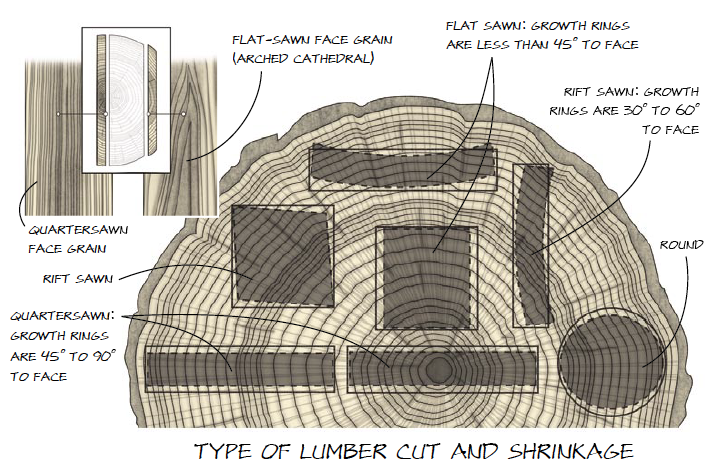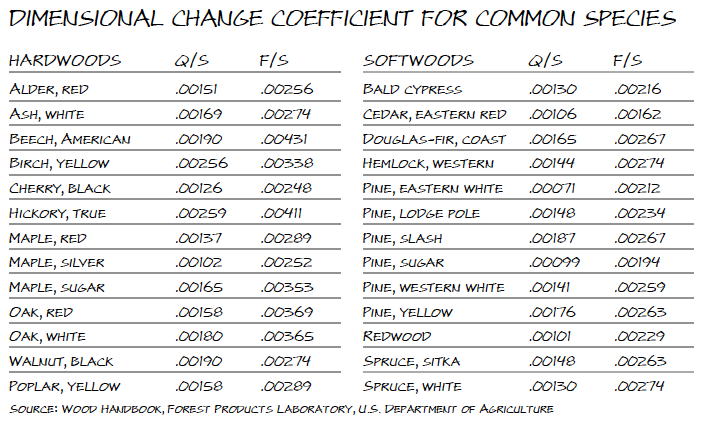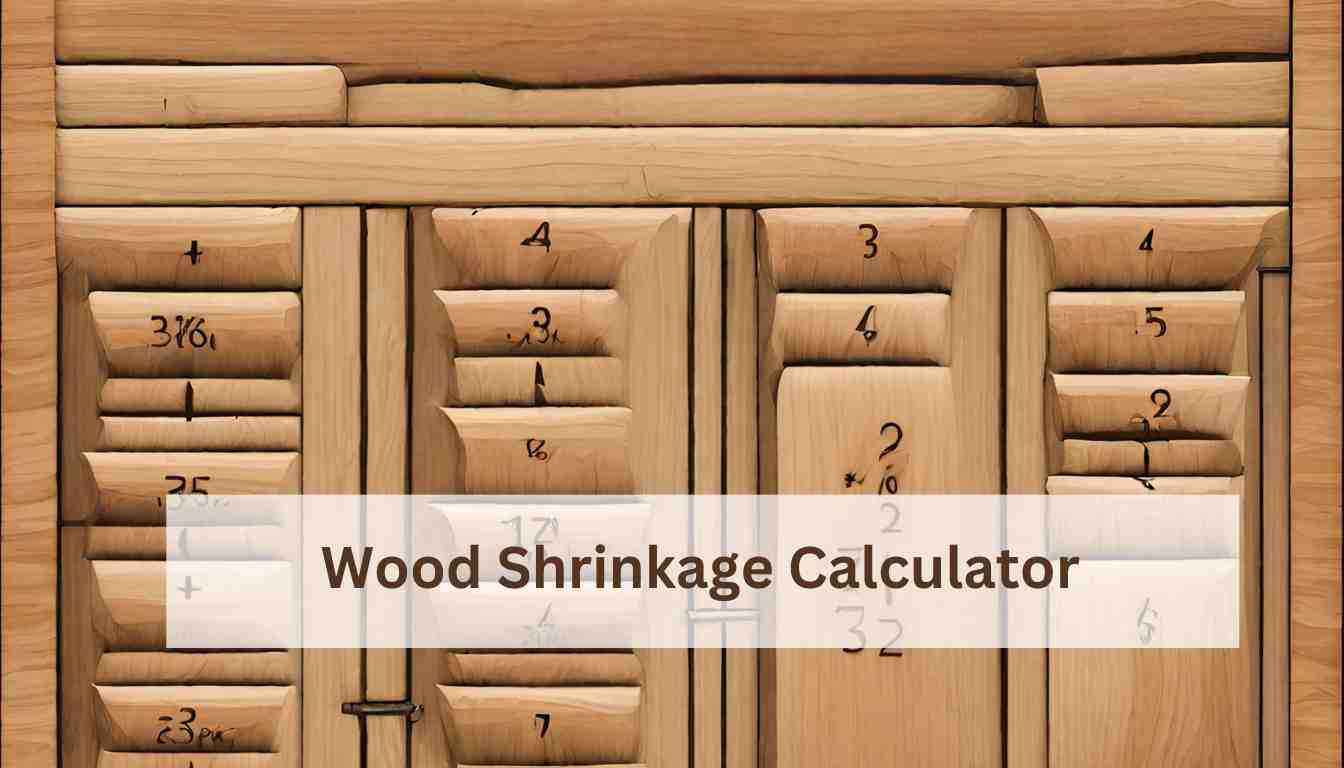A Wood Shrinkage Calculator estimates the dimensional change in wood due to moisture variations. It helps predict wood contraction and expansion.
Wood Shrinkage Calculator
Woodworking projects require precise measurements, and wood shrinkage can be a significant challenge. As wood loses or gains moisture, it changes in size—an aspect crucial for the success of joinery and the overall stability of wooden structures. Understanding the moisture content (MC) of wood and anticipating how it will adapt to environmental conditions is key to any carpentry or wood-related endeavor.
A Wood Shrinkage Calculator becomes an essential tool for carpenters, architects, and DIY enthusiasts. It allows users to input specific factors such as wood species, initial moisture content, and target moisture level to calculate expected dimensional changes. This foresight enables the planning for gaps, tolerances, and material selection to ensure the integrity and aesthetics of a finished wood product.
Introduction To Wood Shrinkage
Understand wood shrinkage with ease using our Wood Shrinkage Calculator. It simplifies predicting dimensional changes in lumber, helping you plan and build with precision.
Wood shrinkage is a natural phenomenon. It happens as wood loses moisture. Understanding shrinkage is key for woodwork. This process can affect everything made of wood. From furniture to house frames.
The Science Behind Wood Shrinkage
Wood is made up of cells that hold water. When wood dries, these cells lose water and the wood gets smaller. Think of it like a sponge. When a sponge dries, it shrinks. Wood works in a similar way. This shrinking can vary depending on many things like:
- Wood species: Different types of wood behave differently.
- Moisture levels: More water means more shrinkage.
- Temperature and humidity: They affect how quickly wood dries.
Importance Of Accurate Measurements
Getting measurements right is important. If not, wood projects may not fit together properly. Builders and woodworkers must plan for shrinkage. They use a wood shrinkage calculator. This tool helps predict how much wood will shrink. By entering details like:
| Wood Type | Initial Moisture | Final Moisture | Dimensions |
|---|---|---|---|
| Oak | 18% | 8% | 2×4 |
| Pine | 15% | 10% | 2×6 |
The calculator gives an estimate of the final size. This avoids gaps or overlaps in wood projects. It ensures durability and quality.

Credit: www.popularwoodworking.com
Factors Influencing Wood Shrinkage
Wood shrinkage is a natural phenomenon that occurs when moisture within wood fibers evaporates. Understanding the factors that influence wood shrinkage is crucial for carpenters, woodworkers, and anyone involved in wood construction. These factors determine the dimensional stability of wood. Let’s delve into the primary factors affecting wood shrinkage.
Moisture Content And Its Impact
Moisture content plays the pivotal role in wood shrinkage. As wood dries, it loses moisture causing it to contract.
- Wet wood is bigger; as it dries, it shrinks.
- Balance moisture with the environment is a key to stability.
- Wood reaches a point where it no longer shrinks or swells – the equilibrium moisture content (EMC).
Wood Species And Shrinkage Rates
Different species of wood have unique shrinkage rates based on their density and fiber structure.
| Wood Species | Shrinkage Rate (%) |
|---|---|
| Oak | 10-14 |
| Pine | 7-11 |
| Maple | 9-12 |
Temperature And Humidity Considerations
Temperature and humidity affect wood’s EMC. High temperatures and humidity can lead to greater wood expansion. In contrast, low humidity and cool temperatures cause more shrinkage.
- Use a dehumidifier in damp conditions to reduce swelling.
- In dry climates, a humidifier can minimize shrinkage.
- Store wood in a temperature-controlled environment.
Tools For Measuring Wood Shrinkage
In the woodworking world, precision is key. Wood shrinkage, a common concern, affects project integrity. Knowing how much wood will shrink helps craftsmen plan and execute their work. Wood shrinkage calculators and tools are vital in this process. They provide insights into dimensional changes wood undergoes. Let’s explore the tools that make woodworking projects more predictable and excellent.
Traditional Measuring Techniques
Conventional tools have been guiding woodworkers for centuries. The common measuring tape, calipers, and moisture meters assist in approximating wood shrinkage.
- Measuring Tapes – Stretch across the wood for length changes.
- Calipers – Determine the width and thickness differences.
- Moisture Meters – Gauge water content to predict shrinkage.
Craftspeople write down these measurements at different times to track the shrinkage rate. Woodworkers use a wood shrinkage chart to estimate the final size.
Advancements In Wood Measurement Technology
Technology revolutionizes wood measurement. Digital tools bring precision and ease to the process.
- Digital Calipers – Offer exact measurements, easy to read.
- Laser Measuring Tools – Provide distant measurements with touch-less efficiency.
- Computer Software – Predicts wood movement using species-specific data.
The standout feature is the digital wood shrinkage calculator. Users input species, size, and moisture levels. In return, they get accurate shrinkage projections. These tools are game-changers for woodworkers seeking flawless finishes.
Designing A Wood Shrinkage Calculator
Wood shrinkage is a critical factor for builders, carpenters, and DIY enthusiasts. The right tool saves time and reduces errors. Enter the Wood Shrinkage Calculator, a bespoke solution aimed at streamlining projects. This post delves into the design of such a calculator.
Key Features And Functionality
A Wood Shrinkage Calculator must be precise and comprehensive. Its design focuses on incorporating key elements:
- Species Selection: Includes a database of wood species, each with specific shrinkage data.
- Dimension Inputs: Allows entry of initial lumber dimensions.
- Moisture Content: Fields to input current and target moisture levels.
- Shrinkage Results: Calculates and displays dimensional changes.
Accuracy is paramount. Users will receive information on the wood’s behavior, aiding in precise cuts and construction.
User Interface Design For Ease Of Use
The interface is clean and intuitive. Buttons are prominent and labels are clear. Input fields are logically arranged for a smooth workflow.
| Component | Description |
|---|---|
| Input Fields | Easily identifiable for quick data entry. |
| Calculation Button | A clear call-to-action initiates the calculation process. |
| Result Display | Results are shown in a highlighted area for quick reference. |
Guided prompts help prevent errors, ensuring an exceptional user experience for professionals and hobbyists alike.
How To Use A Wood Shrinkage Calculator
Embarking on a woodworking project requires precise calculations to ensure the integrity of the final product. A Wood Shrinkage Calculator is a craftsman’s best buddy for predicting the natural shrinkage of wood as it loses moisture. With an online calculator, anyone can accurately forecast changes in wood size and make necessary adjustments. Here’s a simple guide on using this handy tool.
Step-by-step Guide
- Select Wood Species: Start by choosing the type of wood from the calculator’s dropdown menu; each species has unique shrinkage properties.
- Input Moisture Levels: Enter the current and desired moisture content percentages for your wood.
- Add Dimensions: Provide the initial measurements of the wood (length, width, and thickness) in the appropriate fields.
- Hit Calculate: Once all data is entered, click the ‘Calculate’ button to see how much the wood will shrink.
- Read Results: The calculator reveals the wood’s expected size after shrinkage. Use this information to plan cuts and joinery.
Common User Errors And Troubleshooting
Mistakes can occur during data entry or due to misunderstanding the measurements. Let’s address these common errors:
- Incorrect Moisture Content:
- Ensure you’ve got the right moisture levels; triple-check with a moisture meter if necessary.
- Mixing Units:
- Stick to one unit of measurement throughout the process to avoid miscalculations.
- Overlooking Wood Species:
- Different woods behave differently; always select the species that you are working with.
- Not Accounting for Local Climate:
- Consider your region’s climate as it affects wood moisture and, consequently, shrinkage.
- Ignoring Calculator’s Limitations:
- Understand that extreme cases may require a professional’s insight beyond what the calculator provides.
By following these instructions and addressing common errors, you can confidently use a Wood Shrinkage Calculator to inform your woodworking projects.

Credit: blog.carbideprocessors.com
Interpreting Calculator Results
Wood shrinkage calculators are essential for professionals in woodworking and construction. They help you predict how much a piece of wood will shrink or swell under different conditions. This section will aid you in understanding the numbers the calculator provides.
Reading And Understanding Output Data
The results from your wood shrinkage calculator give detailed insights. You’ll see percentages pointing to possible shrink or swell. Interpreting these numbers is crucial for your project’s success. Here’s what you’ll typically find in the output data:
- Original Dimensions: The starting size of your wood material.
- Adjusted Dimensions: Expected size after moisture change.
- Shrinkage Percentage: The expected reduction size, in percentage.
Comparing these figures with your project requirements is important. You will make sure your wood fits perfectly in its final place.
Making Adjustments Based On Results
Once you have the results, adjustments may be necessary. Here’s how to act on the data the calculator provides:
| Result | Action |
|---|---|
| High Shrinkage | Plan for larger initial dimensions or choose a different wood type. |
| Minimal Change | Proceed as planned, but keep monitoring moisture levels. |
Make note of these results and factor them into your wood selection and construction plans. This ensures the longevity and fit of your woodwork.
Application Of Wood Shrinkage Calculators In Industry
The accurate calculation of wood shrinkage is crucial across various industries. Wood Shrinkage Calculators provide vital data. These tools ensure precise measurements. They account for moisture content changes in wood. Let’s dive into their applications.
Construction And Carpentry Uses
Wood Shrinkage Calculators serve as an essential tool for contractors and carpenters. They help predict changes in wood. This prevents future structural issues. The calculators guide in selecting the correct wood dimensions. They match building requirements. Key uses in construction include:
- Calculating wood frame adjustments: Ensuring fit despite weather changes.
- Estimating joint allowances: Preventing cracks and gaps in structures.
- Guiding wood floor installations: Accounting for expansion and contraction.
Every project benefits from precise shrinkage calculations. Builders avoid costly repairs. They deliver long-lasting structures.
Furniture Manufacturing And Custom Design
Furniture makers rely on Wood Shrinkage Calculators. Custom designs need accuracy. Varied humidity levels affect wood differently. Key applications in furniture making include:
- Determining material cuts: Guaranteeing size stability in diverse environments.
- Ensuring joinery integrity: Joints stay tight over time.
- Enhancing material selection: Choosing woods less prone to shrinkage.
Using these calculators streamlines production. Makers craft pieces to last. They avoid customer dissatisfaction. They maintain reputation for quality.
Improving Wood Project Outcomes
Fine woodworking combines art with engineering. To create long-lasting, beautiful pieces, understanding wood behavior is essential. Wood reacts to moisture in the environment. It can expand or shrink. Mistakes in accounting for this movement lead to gaps or cracks. A Wood Shrinkage Calculator is a vital tool for any wood project. It predicts changes in wood size. This tool is key to enhancing craft quality.
Combining Technology With Craftsmanship
The marriage of traditional methods and modern technology yields superior results. The Wood Shrinkage Calculator embodies this union. It allows woodworkers to anticipate and compensate for material movement. Use of this digital tool ensures every cut takes future wood movement into account. Here’s how it helps:
- Accurate material estimates prevent waste.
- Improves fit and finish for complex joinery.
- Provides a guide for optimal wood conditioning before beginning a project.
Ensuring Durability And Precision
Durability and precision in woodworking are non-negotiable. The Wood Shrinkage Calculator informs craftsmen. It helps to make smart design choices. Structures become stable and precise. Woodworkers input species, dimensions, and environmental data. The calculator processes these. It outputs anticipated movement. Here’s the outcome:
- Enhanced structural integrity for furniture and architectural elements.
- Seamless integration with other materials that may not move.
- Customized outcomes that consider local climate conditions.

Credit: www.timberaid.com
Frequently Asked Questions On Wood Shrinkage Calculator
What Is A Wood Shrinkage Calculator?
A Wood Shrinkage Calculator is a tool used to estimate the dimensional changes in wood due to variations in relative humidity. It helps in planning accurate woodworking projects.
How Does Moisture Affect Wood Shrinkage?
Wood expands or contracts based on moisture levels. Higher humidity causes swelling, while lower humidity leads to shrinkage, impacting the size and stability of wooden structures.
Can I Prevent Wood From Shrinking?
Preventing wood shrinkage entirely is not possible, but it can be minimized. Use seasoned wood, control the environmental moisture, and design with shrinkage in mind to reduce effects.
What Factors Influence Wood Shrinkage?
Wood shrinkage is influenced by wood species, initial moisture content, and changes in ambient humidity. Grain orientation also plays a significant role in how wood reacts.
Conclusion
Wrapping up our discussion on wood shrinkage calculators, we’ve covered their value for any woodworking project. By leveraging such tools, precision and reliability are enhanced, ensuring that your creations maintain their intended dimensions and quality. Remember, a wood shrinkage calculator isn’t just a suggestion; it’s an essential resource for craftsmen dedicated to excellence.


